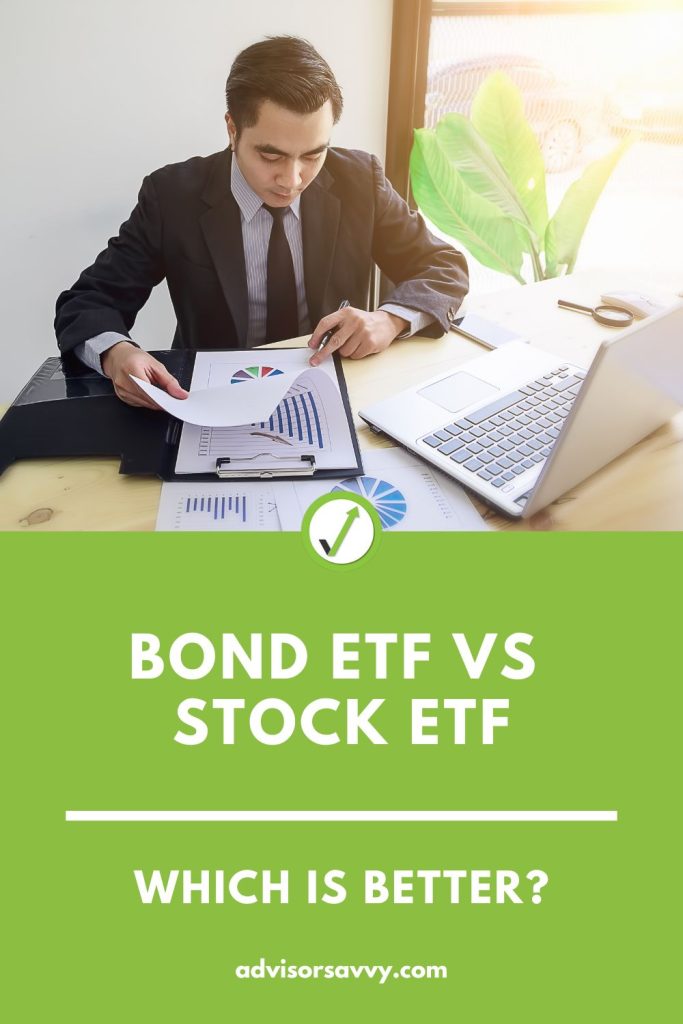
The goal of most investors is to generate wealth and achieve a diversified, balanced portfolio. There are many investing tools to consider if you want to earn a steady return. One of the most common options is an exchange-traded fund, or ETFs for short. There are many types of ETFs on the market. Two types include bond ETFs and stock ETFs. But how do they differ and which is better in the bond ETF vs stock ETF debate? In this article, you will learn the basics of these two types of ETFs to build a better portfolio. Let’s find out how bond ETFs vs stock ETFs can impact your investment strategy.

Table of contents
Bond ETF vs Stock ETF: What’s the difference?
Exchange-traded funds are a bundle of assets and securities containing hundreds of investable assets like stocks and bonds. They each have different risk and return profiles. For this reason, investors should carefully consider their investment goals to help them decide between bond ETF vs stock ETF. Here’s some key differences to consider:
- Bond ETFs are most suitable for conservative investors interested in earning income, while stock ETFs are best for long-term investors seeking growth. Stock ETFs provide some income in dividends but are not designed to provide regular income.
- Both bond ETFs and stock ETFs can offer diversification benefits. However, bond ETFs provide diversification by investing in bonds with different maturities and credit ratings. Stock ETFs can provide diversification by investing in stocks within varying sectors and market capitalizations.
- To generate income, bond ETFs invest in a portfolio of fixed-income securities, such as government bonds, corporate bonds, and municipal bonds. On the other hand, stock ETFs invest in a portfolio of stocks to generate capital increase.
CIBC Investor’s Line Offer
Up to $6.95 per online stock or ETF trade. Plus, there’s no minimum account balance.
What are bond ETFs?
A bond ETF is an exchange-traded fund that invests in fixed-income securities, primarily bonds. This form of debt security represents a loan from an investor to a borrower such as a government or a corporation. It is designed to track bonds rather than trying to manage a bond portfolio to supersede a benchmark index.
Bond ETFs can come in several forms, as they are categorized based on factors like maturity and credit ratings. When you invest in a bond ETF, you can also gain exposure to a diversified portfolio of bonds with lower transaction costs and greater liquidity.
The value of bond ETFs fluctuates based on changes in market value, credit quality, interest rates, and other factors affecting the bond market. Some bond ETFs may also pay regular interest income to investors, which can provide a regular flow of income. Examples of bond ETFs include the following:
Government Bond ETFs, which are backed by bonds issued by a government body. Examples include:
- Bond index ETFs: These ETFs aim to track or outperform a certain index, such as the S&P Canada Aggregate Bond Index.
- Floating rate bond ETFs: Instead of tracking a fixed rate bond, these ETFs track floating rate bonds. In other words, the interest payments on the backed security fluctuate.
- Fixed rate bond ETFs: The opposite of floating rate bond ETFs. These ETFs track fixed rate bonds where the interest payments on the backed security are steady and reliable.
Corporate bond ETFs, which are issued by corporate or private entities. Examples include:
- Investment Grade ETF: These bond ETFs are issued according to different ratings. Moreover, they carry a minimum risk of default and low return.
- Junk Bond ETF: These bond ETFs are issued by a company with a lower credit risk rating. They offer a high rate of return, however, there is a high risk.
What are stock ETFs?
A stock ETF is another type of exchange-traded fund that invests in stocks for long-term growth, which represents ownership in a company. They are designed to track the performance of an underlying benchmark index. Or, they may aim to invest in a particular sector, such as tech, healthcare, or gold.
When you invest in a stock ETF, you gain exposure to a diversified portfolio of stocks with low transaction costs and greater liquidity. While they are typically less risky than individual stocks, they are slightly more risky than bond ETFs.
Stock ETFs can provide a way to invest in a specific market sector like emerging markets or tech industries, without choosing individual stocks. Some stock ETFs may also pay dividends to investors, which can serve as a source of income and potential capital gains. However, they tend to be less consistent than dividends or returns paid by bond ETFs.
Related Reading: How to Buy Bonds in Canada
CIBC Investor’s Line Offer
Up to $6.95 per online stock or ETF trade. Plus, there’s no minimum account balance.
Bond ETF vs Stock ETF: Advantages and Disadvantages
In today’s investment landscape, you can choose between bond ETF vs stock ETF and pick the one that best suits your plans. No matter the type of ETF you choose, it should be based on the current economic environment including your investment strategy.
What is the upside of bond ETF?
Below are some of the advantages of investing in bond ETFs:
- Income: A lot of investors access regular interest income through bond ETFs, which can provide a steady inflow of cash.
- Low minimum investment: Bond ETFs can offer a low minimum investment. This makes ETFs more accessible to investors who may not have the capital to invest in individual bonds.
- Stability: Bond ETFs generally produce stable returns over time, making them suitable for investors interested in earning long-term income.
- Diversification: Bond ETFs offer a way to diversify a portfolio by investing in bonds with different features, including maturities and credit ratings. It helps to reduce risk and provide more stable returns.
- Liquidity: Bond ETFs are traded on stock exchanges, making them more liquid than individual bonds. In other words, investors can easily buy and sell bond ETFs at low transaction costs.
What is the downside of bond ETF?
Here are the disadvantages of investing in bond ETFs:
- Interest rate risk: Bond prices are sensitive to changes in interest rates. If interest rates rise, bond prices may fall, which could devalue the bond ETF.
- Fees: Bond ETFs charge fees, which can reduce returns over time. When choosing a bond ETF, it is important to compare the fees of different bond ETFs to find the most suitable option.
- Market risk: The value of a bond ETF can fluctuate based on various factors, including changes in the bond market, interest rates, and credit quality.
- Credit risk: Bond ETFs are also subject to credit risk. This risk is greater for bond ETFs that invest in non-investment-grade bonds.
- Low-performance rate: Bond ETFs produce returns over time but significantly below-average returns for stocks.
Related Reading: 5 Best Money Market ETFs in Canada
What is the upside of a stock ETF?
Below are some of the advantages of investing in stock ETFs:
- Potential for high returns: Stock ETFs generally produce higher returns over time compared to other assets like bonds, commodities, and real estate.
- Cost-effective: Stock ETFs also have lower fees, which can help to maximize returns over time.
- Low minimum investment: The minimum investment for stock ETFs is the price of an individual share, which is often lower than the minimum investment for a portfolio of individual stocks.
- Diversification: Stock ETFs can help you gain exposure to a diversified portfolio of stocks. This helps to reduce risk and provide more stable returns.
What is the downside of stock ETF?
The following are the disadvantages of investing in stock ETFs:
- Market risk: The value of a stock ETF can fluctuate based on changes in the market value and overall market conditions.
- Lack of investment selection control: When investing in a stock ETF, one may not be able to select individual stocks themselves, and may depend on the fund manager’s selection index. This is a disadvantage for investors who want to have control over personal investment decisions.
- Underperformance level: Stock ETFs are designed to track a specific index or industry, which may not perform well in the market. This will cause investors to miss out on potential gains from individual stocks that are effective in market performance.
- Lower dividend income: Some stock ETFs may not provide as much dividend income as individual stocks. This is a huge disadvantage for investors interested in earning an income of their investments.
Are bond ETFs safer than stock ETFs?
When it comes to bond ETF vs stock ETF, there isn’t one better than the other. Despite their differences, you can invest in both to diversify your portfolio. Ultimately, the decision to invest in one or both choices depends on your budget, investment goals and risk tolerance.
Investing in ETFs is a great choice if you want to diversify your holdings to reduce any investment risk. However, bond ETFs are usually best for conservative investors and those seeking income from their investments. Whereas stock ETFs are best for long-term investors seeking growth. Investing in both ETF types can complement each other and can help you build a diversified portfolio.
Read More: US Bond ETF in Canada

Match to your perfect advisor now.
Getting started is easy, fast and free.

